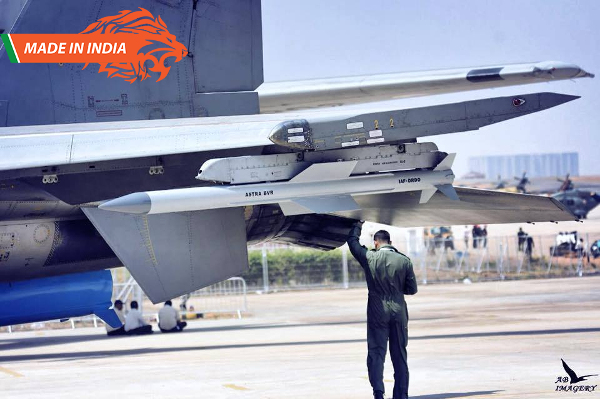India has successfully developed the ‘Astra’, its first all-weather Beyond Visual Range (BVR) Air-to-Air Missile (AAM) and leaped into a group of few nations that have a weapon system of this capability and performance. The Defence Research and Development Organisation (DRDO) initiated concept studies for developing an indigenous AAM in the 1990s. The Government of India sanctioned the Astra project in March 2004 with a budget of `995 crore. The Hyderabad-based Defence Research & Development Laboratory, a Missile System laboratory under the DRDO was designated as the design and development (D&D) agency for the Astra missile.
During its development, the design of Astra missile went through several iterative changes for improving its control, guidance and propulsion systems as also reduction in weight. Ground testing of the Astra began in December 2012 and the missile was cleared for captive flight trials on the Su-30MKI combat platform in April 2013. The first Astra missile was launched from the Su-30MKI in May 2014 and so far, 27 missiles have been test fired to ascertain and validate its performance.
The Astra is designed to carry 15 kg high explosive prefragmented warhead, which is activated by a Radio Proximity Fuse. The missile has good Electronic Counter-Countermeasure (ECCM) to enable unconstrained operation in an Electronic Countermeasure (ECM) environment. The Astra Mark 1, which successfully completed the trials recently, has a maximum head-on launch range of 100 km, a speed of 4.5 Mach and is cleared for launch up to an altitude of 20 km (66,000 ft).
The Astra could be launched either by the mother aircraft or fired in buddy mode. The extensive and rigorous trials have successfully validated the Astra missile’s warhead capability, its maximum launch ranges against both head-on and manoeuvring targets, its long-range target engagement capability, clear missile-separation at supersonic speeds, launch under high ‘g’ forces and multiple missile launches at multiple targets. During the trials, the Astra missiles were launched across the entire flight envelope of the Su-30MKI and all of these successfully engaged, hit and destroyed all assigned manoeuvring and non-manoeuvring aerial targets besides meeting with all mission objectives.
After launch, the Astra initially uses ‘Inertial Mid-Course Guidance’ through a secure data-link from the mother aircraft followed by ‘Active Radar Homing’ from its seeker head for terminal guidance. To absorb delays in the development process of the indigenous active radar seeker, it was decided to develop the Astra missile with Russian ‘Agat 9B1103M’ active radar seeker for terminal guidance. The entire D&D of Astra including the firing trials up to the year 2017, were conducted with the Russian active radar seeker. The decision to use the Russian seeker for D&D and trials phases was a very prudent one as it enabled concurrent engineering and development of both, the missile and its active radar seeker independently.
The Indian Ku-band active radar seeker was developed by DRDO and is now fully functional. This form-fit indigenous seeker has now been installed on all Astra missiles. Thus, today India has its first indigenously developed BVR AAM with indigenous active radar seeker. The Indian Air Force (IAF) being satisfied with Astra’s development and performance, is in the process of placing initial order for 100 missiles in the prototype version on the manufacturer Bharat Dynamics Limited (BDL). Induction of this wapons system into the IAF will commence later this year.
Performance and kill ranges of the Astra Mark 1 is slightly better than the BVR AAM currently employed by our adversaries. The Astra is already integrated on the Su-30MKI and the IAF will certainly integrate this weapons system with the upgraded Mirage 2000, the MiG-29, light combat aircraft Tejas and may be with the Rafale jets that are expected to start arriving in September this year. The Astra is the first Beyond Visual Range, Air-to-Air Missile that is designed, developed and manufactured by the Indian aerospace industry. Its successful induction will greatly boost the BVR combat capability of the IAF.
After the successful development of the Astra Mark 1, the first BVR AAM, the IAF and DRDO have already started the process to develop Astra Mark 2, an improved version of Astra Mark 1. The Astra Mark 2 will have a head-on launch range of over 100 km along with the capability for ejector launch. It is certain that the Astra Mark 2 will be one of the best BVR AAM capable of outperforming all current BVR AAM except the European Meteor that is coming with the 36 Rafale fighters.
Successful indigenous design and development of the Astra BVR AAM coupled with Akash Mark 2 SAM, signposts the maturity of the Indian weapons industry in mastering cutting-edge missile technologies as also helping the ‘Make in India’ campaign and reinforcing national defence.
Source: SPG
Image Courtesy: IDU
You may also like
-
IAF Aircraft Set Course For Exercise Eastern Bridge VII At Oman
-
IAF Set To Host The Indian Defence Aviation Exposition-II At Jodhpur
-
Defence Secretary to co-chair 5th India-Philippines Joint Defence Cooperation Committee meeting in Manila
-
Simultaneous Launch Of ‘malpe And Mulki’, Fourth And Fifth Ships Of Asw Swc (Csl) Project
-
Aatmanirbharta in Defence: MoD signs Contract with HAL for 240 AL-31FP Aero Engines for Su-30MKI Aircraft
